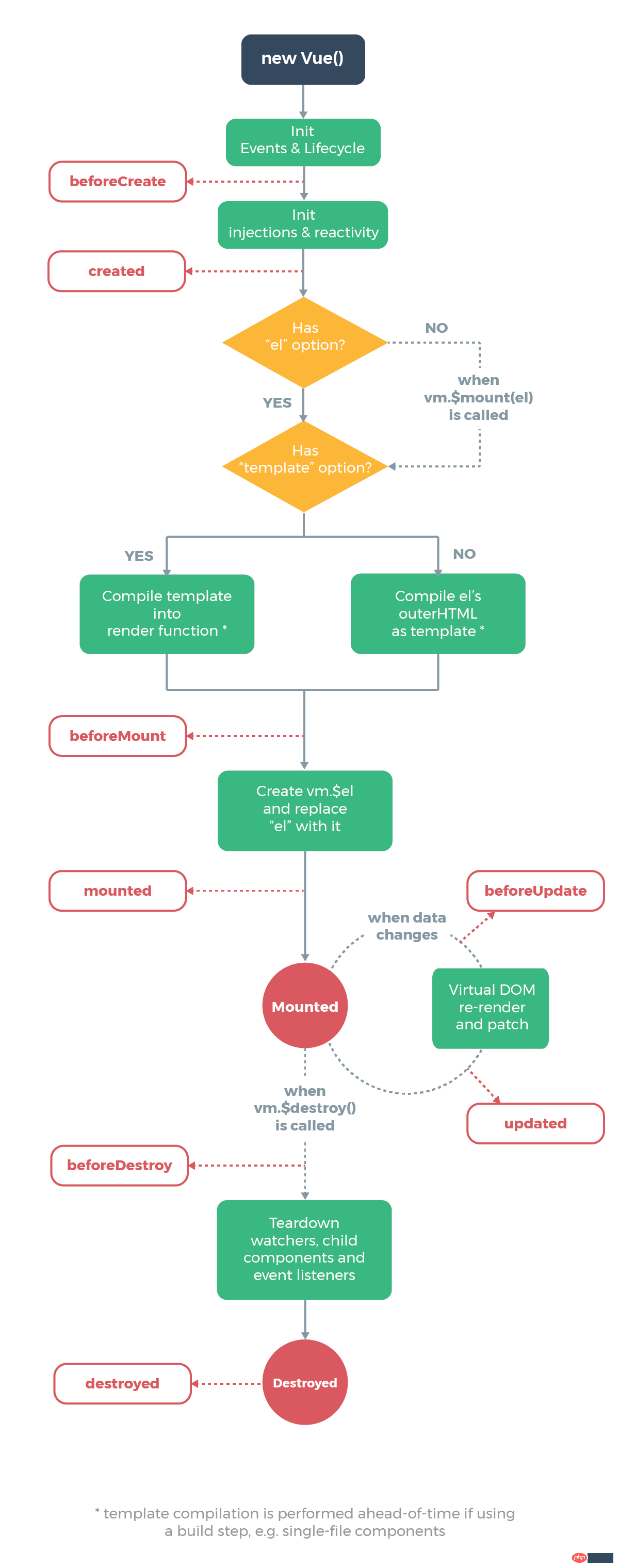Detailed explanation of created method use cases
This time I will bring you a detailed explanation of the use cases of the created method. What are the precautions when using the created method. The following is a practical case, let's take a look.
InstanceLife cycle
Each Vue instance goes through a series of initialization processes before being created. For example, the instance needs to configure data observer, compile the template, mount the instance to the DOM, and then update the DOM when the data changes. During this process, the instance will also call some life cycle hooks, which provides us with the opportunity to execute custom logic. For example, the created hook is called after the instance is created:
var vm = new Vue({
data: {
a: 1
},
created: function () {
// `this` 指向 vm 实例
console.log('a is: ' + this.a)
}
})
// -> "a is: 1"There are also some other hooks that are called at different stages of the instance life cycle, such as mounted, updated, destroyed. The hook's this points to the Vue instance that called it. Some users may ask whether Vue.js has a concept of "controller"? The answer is, no. A component's custom logic can be distributed among these hooks.
Life cycle diagram
The following figure illustrates the life cycle of an instance. You don't need to understand everything right away, but it will help later.

Added:
##VThe difference between mounted and created in the ue life cycle
1. What is the life cycle?
In popular language, it is a series of processes that an instance or component in Vue goes through from creation to destruction. Although it is not rigorous, it is basically understandable. Through a series of practices, now I have sorted out all the problems encountered, and today I will record the difference between created and mounted:2. What is the difference between created and mounted?
The official diagram is as follows:
template Called before rendering into html, that is, some attribute values are usually initialized before rendering into a view.
mounted: Called after the template is rendered into html, usually after the initialization page is completed, and then performs some required operations on thedom node of the html.
In fact, the two are easier to understand. Created is usually used more often, while mounted is usually operated in the use of some plug-ins or the use of components, such as the use of the plug-in chart.js. : var ctx = document.getElementById(ID); Usually there is this step, and if you write it into the component, you will find that you cannot perform some initial configuration of the chart in created. You must wait for this html It can only be done after rendering, so mounted is the best choice. Let’s look at an example (using components).
<span style="font-size: 14px;">Vue.component("demo1",{
data:function(){
return {
name:"",
age:"",
city:""
}
},
template:"<ul><li id='name'>{{name}}</li><li>{{age}}</li><li>{{city}}</li></ul>",
created:function(){
this.name="唐浩益"
this.age = "12"
this.city ="杭州"
var x = document.getElementById("name")//第一个命令台错误
console.log(x.innerHTML);
},
mounted:function(){
var x = document.getElementById("name")/</span>/第二个命令台输出的结果<span style="font-size: 14px;">
console.log(x.innerHTML);
}
});
var vm = new Vue({
el:"#example1"
})</span>
 You can see that everything is assigned in created It was successfully rendered with the initial value.
You can see that everything is assigned in created It was successfully rendered with the initial value.
But at the same time, look at the console as follows:
 #You can see that the first one reported an error, which is actually because the id cannot be found, getElementById(ID) The element was not found for the following reasons:
#You can see that the first one reported an error, which is actually because the id cannot be found, getElementById(ID) The element was not found for the following reasons:
When created, the html in the view was not rendered, so if you directly operate the dom node of the html at this time, you will not be able to find the relevant elements
In mounted, since the html has been rendered at this time, the dom node can be directly operated, so the result "Tang Haoyi" is output.
I believe you have mastered the method after reading the case in this article. For more exciting information, please pay attention to other related articles on the php Chinese website!
Recommended reading:
How to convert the key-value string into a json string (with code)
angular4 multiple components communicate data with each other
The above is the detailed content of Detailed explanation of created method use cases. For more information, please follow other related articles on the PHP Chinese website!

Hot AI Tools

Undresser.AI Undress
AI-powered app for creating realistic nude photos

AI Clothes Remover
Online AI tool for removing clothes from photos.

Undress AI Tool
Undress images for free

Clothoff.io
AI clothes remover

Video Face Swap
Swap faces in any video effortlessly with our completely free AI face swap tool!

Hot Article

Hot Tools

Notepad++7.3.1
Easy-to-use and free code editor

SublimeText3 Chinese version
Chinese version, very easy to use

Zend Studio 13.0.1
Powerful PHP integrated development environment

Dreamweaver CS6
Visual web development tools

SublimeText3 Mac version
God-level code editing software (SublimeText3)

Hot Topics
 Detailed explanation of obtaining administrator rights in Win11
Mar 08, 2024 pm 03:06 PM
Detailed explanation of obtaining administrator rights in Win11
Mar 08, 2024 pm 03:06 PM
Windows operating system is one of the most popular operating systems in the world, and its new version Win11 has attracted much attention. In the Win11 system, obtaining administrator rights is an important operation. Administrator rights allow users to perform more operations and settings on the system. This article will introduce in detail how to obtain administrator permissions in Win11 system and how to effectively manage permissions. In the Win11 system, administrator rights are divided into two types: local administrator and domain administrator. A local administrator has full administrative rights to the local computer
 Detailed explanation of the mode function in C++
Nov 18, 2023 pm 03:08 PM
Detailed explanation of the mode function in C++
Nov 18, 2023 pm 03:08 PM
Detailed explanation of the mode function in C++ In statistics, the mode refers to the value that appears most frequently in a set of data. In C++ language, we can find the mode in any set of data by writing a mode function. The mode function can be implemented in many different ways, two of the commonly used methods will be introduced in detail below. The first method is to use a hash table to count the number of occurrences of each number. First, we need to define a hash table with each number as the key and the number of occurrences as the value. Then, for a given data set, we run
 Detailed explanation of division operation in Oracle SQL
Mar 10, 2024 am 09:51 AM
Detailed explanation of division operation in Oracle SQL
Mar 10, 2024 am 09:51 AM
Detailed explanation of division operation in OracleSQL In OracleSQL, division operation is a common and important mathematical operation, used to calculate the result of dividing two numbers. Division is often used in database queries, so understanding the division operation and its usage in OracleSQL is one of the essential skills for database developers. This article will discuss the relevant knowledge of division operations in OracleSQL in detail and provide specific code examples for readers' reference. 1. Division operation in OracleSQL
 Detailed explanation of remainder function in C++
Nov 18, 2023 pm 02:41 PM
Detailed explanation of remainder function in C++
Nov 18, 2023 pm 02:41 PM
Detailed explanation of the remainder function in C++ In C++, the remainder operator (%) is used to calculate the remainder of the division of two numbers. It is a binary operator whose operands can be any integer type (including char, short, int, long, etc.) or a floating-point number type (such as float, double). The remainder operator returns a result with the same sign as the dividend. For example, for the remainder operation of integers, we can use the following code to implement: inta=10;intb=3;
 Detailed explanation of the usage of Vue.nextTick function and its application in asynchronous updates
Jul 26, 2023 am 08:57 AM
Detailed explanation of the usage of Vue.nextTick function and its application in asynchronous updates
Jul 26, 2023 am 08:57 AM
Detailed explanation of the usage of Vue.nextTick function and its application in asynchronous updates. In Vue development, we often encounter situations where data needs to be updated asynchronously. For example, data needs to be updated immediately after modifying the DOM or related operations need to be performed immediately after the data is updated. The .nextTick function provided by Vue emerged to solve this type of problem. This article will introduce the usage of the Vue.nextTick function in detail, and combine it with code examples to illustrate its application in asynchronous updates. 1. Vue.nex
 Detailed explanation of the role and usage of PHP modulo operator
Mar 19, 2024 pm 04:33 PM
Detailed explanation of the role and usage of PHP modulo operator
Mar 19, 2024 pm 04:33 PM
The modulo operator (%) in PHP is used to obtain the remainder of the division of two numbers. In this article, we will discuss the role and usage of the modulo operator in detail, and provide specific code examples to help readers better understand. 1. The role of the modulo operator In mathematics, when we divide an integer by another integer, we get a quotient and a remainder. For example, when we divide 10 by 3, the quotient is 3 and the remainder is 1. The modulo operator is used to obtain this remainder. 2. Usage of the modulo operator In PHP, use the % symbol to represent the modulus
 Detailed explanation of the linux system call system() function
Feb 22, 2024 pm 08:21 PM
Detailed explanation of the linux system call system() function
Feb 22, 2024 pm 08:21 PM
Detailed explanation of Linux system call system() function System call is a very important part of the Linux operating system. It provides a way to interact with the system kernel. Among them, the system() function is one of the commonly used system call functions. This article will introduce the use of the system() function in detail and provide corresponding code examples. Basic Concepts of System Calls System calls are a way for user programs to interact with the operating system kernel. User programs request the operating system by calling system call functions
 Detailed explanation of Linux curl command
Feb 21, 2024 pm 10:33 PM
Detailed explanation of Linux curl command
Feb 21, 2024 pm 10:33 PM
Detailed explanation of Linux's curl command Summary: curl is a powerful command line tool used for data communication with the server. This article will introduce the basic usage of the curl command and provide actual code examples to help readers better understand and apply the command. 1. What is curl? curl is a command line tool used to send and receive various network requests. It supports multiple protocols, such as HTTP, FTP, TELNET, etc., and provides rich functions, such as file upload, file download, data transmission, proxy






